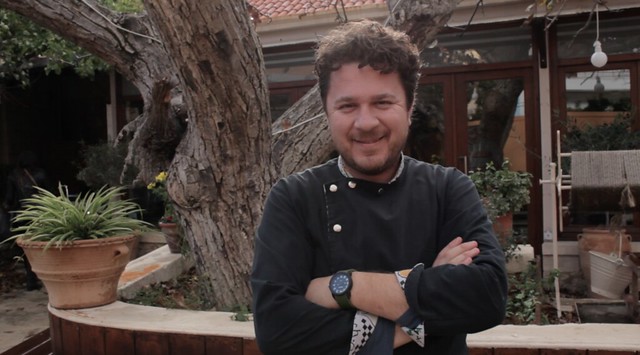Maddie Salters has a Michelin day in a Cretan kitchen.
On my final day in Crete, I was transported from the field to the inside of a kitchen at restaurant Kritamon in the Archanes village with Michelin starred Chef Dimitris Mavrakis.
This is where my days of farming took root in culture and found some finesse. I learned that Cretan food of the type I’d been digging up and dining on all week is so healthy that it had been proven to help solve cardiac problems. I’d readily believe it, if the number of people over the age of seventy I saw jauntily climbing up mountains were any proof.
It’s the combination of olive oil, beans, and greens, greens, greens that really does it.
When I was first introduced to the Treasure of Crete salad at Kritamon, for example, I understood the name choice right away. Served on every Cretan table throughout the winter, it is a salad which combines all of the rural mountains’ native herbs– which cannot be found elsewhere, for the most part. The bitter bite of the salad (Mavrakis informed us that bitterness in greens denotes great digestive and health properties, that they “kill sugar” and cleanse the body) was balanced out by a bit of olive oil and a generous helping of sweet, crunchy pomegranate seeds.
The best herb of the bunch? The “goat’s milk herb”, a tender, string-thin green which also tastes surprisingly like its namesake.
There’s something genuinely charming and engaging about the simplistic style of the food, which the chef told us “isn’t gourmet– French cooking is for rich people, the sort of ingredients that cannot be used every time. But these ancient recipes? They are delicate and simple food.”
However, he also showed us how to add a bit of creative modernity to the Greek palette. We were taught to roll pasta from scratch, and invited to taste each element of the sauce before we added it– pasta not being typically Greek, even if what we added was.
But the highlight? Risotto, cooked in chicken stock, and simmered in local smoked cheese kayfaloderi, sour wheat, and fennel which gives it a bit of an anise aftertaste. A fireplace-flavour that would be at home in cooler places during the winter.
Best of All: “We don’t have recipes. We have products.” What a state of mind! This kind of gastronomy began over 3000 years ago, when clay pots and honey were used to cook– the ancient greeks did not have salt or sugar, but might use sardines to the same effect as salt.
Pro Tip: Many of Crete’s herbs cannot be cultivated outside of Crete because they grow only in rocks by sea, using elements of land and ocean. But you can pick up dried versions of these herbs at local shops, including “Cretan tea”.
Read more posts in Maddie’s Create Eats series.























Pingback: Crete Eats: Round Up of Posts - tikichris